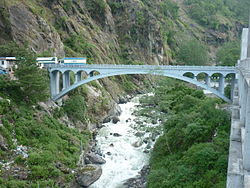The long suspension bridges of Nepal
In 2015, Nepal had a total road network of 80,078 kilometres (49,758 mi) of which 53,143 kilometres (33,022 mi) are local rural roads, of these, only 1,697 kilometres (1,054 mi) has been black-topped. [1] Modern roads are few and mostly concentrated on the Terai plain, the area stretching along the border with India and which accounts for nearly half of the country's population. In 2020, there is only one railway line of 59 kilometers, also located near India and the capital Kathmandu has no railway connection. [2] The population is essentially rural in this region at the foot of the Himalayas, but the steep reliefs are a brake on the development of the local populations who are already among the poorest in the world.


Until the 1950s, the whole country with the exception of the Terai was provided only with trails for a large part of the territory, some essential trade routes had been established since the beginning of the 20th century, despite the isolation of the Nepal. Louis Harper introduced the first modern suspension footbridges to Nepal in the late 1890s, he had improved the system in the United Kingdom from wooden pylons to steel lattice pylons, they were pre-fabricated in Scotland and shipped to site for assembly. At least 4 bridges of this type remain in service in Nepal today. [3] This system was unfortunately not effective and failed to meet significant demand.
All these constraints led the government to create the Suspension Bridges Division in 1964 (replaced by the Trail Bridge Section in 2001) which studied with Swiss engineers a model of durable, easy-to-build simple suspension bridge, adapted to the Nepalese relief and therefore to large spans ranging from 120 to 350 metres (390 to 1,150 ft), and a whole first generation of trail bridges was born on the main axes, with up to 30 bridges built per year. Under an increasingly strong demand, a second generation of bridges had developed with economic and environmental stakes, these bridges are optimized to be built with local materials and carried out by a local workforce in order to extend this system across the country. They will nevertheless have shorter spans than the first generation bridges, in the order of 40 to 120 meters.
By 2004, more than 3000 suspension bridges have thus been built on the Nepalese landscape including 2230 bridges through Swiss support with an overall length of more than 180 kilometres (110 mi). [4] Two types of bridges have been built: 580 long-span trail bridges with lengths ranging from 120 to 350 metres (390 to 1,150 ft) on the main trails under the responsibility of the Department of Local Infrastructure Development and Agricultural Roads and 1650 short-span community bridges up to 120 metres (390 ft) in length, built by the communities themselves under the responsibility of User Committees. [5] In September 2015, a total of 6000 completed trail bridges has been celebrated. [6]
But the needs are still numerous and signs of weakness are beginning to appear, it is estimated that 200 the number of bridges require heavy work, even replacement (statistics mid-2004). Some footbridges are built on great heights in order to fight against flooding during the monsoon, 14 bridges were destroyed during the glacial break-up of Digcho in the Sagarmatha area in 1985. This phenomenon, also called jökulhlaup, is caused by the rupture of a glacier and causes sudden and devastating floods. The devastated bridges were later rebuilt on higher levels.
They are rediscovered today by tourists during organized backpackings on the footpaths of Everest, Annapurna, the Kathmandu Valley and other sites along Nepal.










